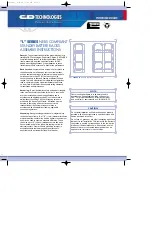
9
①
②
Your monitor should move up and down easily and stay in position.
If the monitor moves down from the desired position, or is hard to
lift, you should
increase
the counterbalance force. If the monitor
moves up from the desired position you should
decrease
the
counterbalance force.
M2.1 And M8.1 Adjustment
1
Push the Upper Link (A) down until the Adjustment Screw (B)
is visible.
2
Using the appropriate hex key (4 mm for M2.1, 5 mm for
M8.1) turn the Adjustment Screw clockwise (towards
+
) to
increase
force, or counter-clockwise (towards
–
) to
decrease
force. Turn the Adjustment Screw (B) until the monitor is
balanced.
3
Move the monitor around to ensure that the motion is smooth
and the arm holds the monitor in place.
NOTE:
When installing several of the same monitors, note the
position of the needle in the Indicator (C) on top of the arm.
Adjust the other arms to match.
M10 Adjustment
1
To access the Adjustment Screw (F), use your finger to pry
open the Cover (E) on the Upper Link (D).
2
Using the 5 mm hex key, turn the Adjustment Screw (F)
clockwise to increase force, or counter-clockwise to
decrease force. Turn the Adjustment Screw until the
monitor is properly balanced.
3
Move the monitor around to ensure that the motion is
smooth and the arm holds the monitor in place.
4
Reposition the Cover (E) and press until it snaps in place.
CAUTION:
Do not over-tighten the Adjustment Screw
as it can damage the arm.
Monitors Should Not Exceed:
15.5 lbs (7 kg) for M2.1
28 lbs (12.7 kg) for M8.1
48 lbs (21.8 kg) for M10
Total Weight Not To Exceed 95 lbs (43 kg)
Weight Adjustments
A
B
D
E
F










































